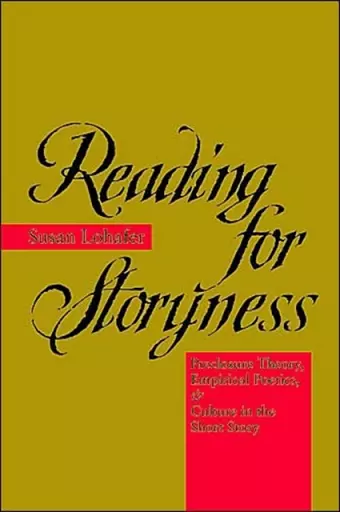Reading for Storyness
Preclosure Theory, Empirical Poetics, and Culture in the Short Story
Format:Hardback
Publisher:Johns Hopkins University Press
Published:22nd Dec '03
Currently unavailable, and unfortunately no date known when it will be back

In her irresistible, jargon-free style, Susan Lohafer expertly investigates the human response to the mystery of story in an important new study that reveres the text and respects the reader. -- Charles May, author of The Reality of Artifice: A Study of the Short Story and editor of Short Story Theories The notion of pre-closure in stories is a fruitful one for writers, critics, and readers. Lohafer's analysis is a clever one because it shows how various kinds of readers pre-fashion-even preempt-stories, but also shows how contemporary stories often embody archaic narrative modes. Reading for Storyness would be a useful teaching book. -- Jean McGarry, The Writing Seminars at the Johns Hopkins University
Reading for Storyness combines cognitive science with literary theory to present a compelling argument for the uniqueness of the short story.The short story has been a staple of American literature since the nineteenth century, taught in virtually every high school and consistently popular among adult readers. But what makes a short story unique? In Reading for Storyness, Susan Lohafer, former president of the Society for the Study of the Short Story, argues that there is much more than length separating short stories from novels and other works of fiction. With its close readings of stories by Kate Chopin, Julio Cortazar, Katherine Mansfield, and others, this book challenges assumptions about the short story and effectively redefines the genre in a fresh and original way. In her analysis, Lohafer combines traditional literary theory with a more unconventional mode of research, monitoring the reactions of readers as they progress through a story-to establish a new poetics of the genre. Singling out the phenomenon of "imminent closure" as the genre's defining trait, she then proceeds to identify "preclosure points," or places where a given story could end, in order to access hidden layers of the reading experience. She expertly harnesses this theory of preclosure to explore interactions between pedagogy and theory, formalism and cultural studies, fiction and nonfiction. Returning to the roots of storyness, Lohafer illuminates the intricacies of classic short stories and experimental forms of surreal, postmodern, and minimalist fiction. She also discusses the impact of social constructions, such as gender, on the identification of preclosure points by individual readers. Reading for Storyness combines cognitive science with literary theory to present a compelling argument for the uniqueness of the short story.
Lohafer explores a unique idea, one 'revolv[ing] around an experiment in which one or more readers identify sentences within a story when the text could end.' Lohafer presents student response to this experiment and goes on to analyze a number of short stories... This approach, deconstructive yet traditional, permits the author to open up new possibilities of interpretation. Choice 2004 Lucid, often subtle and artfully constructed interpretations. -- Richard Walsh Modern Language Review 2006
ISBN: 9780801873980
Dimensions: 229mm x 152mm x 18mm
Weight: 408g
208 pages